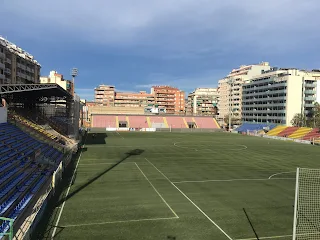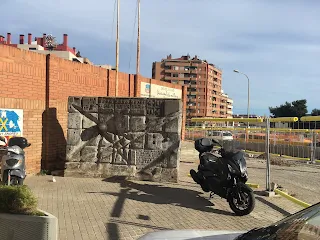Unió Esportiva Sant Andreu is a football club based in the Sant Andreu district of the Spanish city of Barcelona, formed on January 21st 1909, as Club de Futbol Andreuenc.
The inspiration behind the club came from Scots working in the city’s spinning mills in the industrial part of Barcelona between Sant Andreu and Sant Martí. They formed Foot-ball Club Escocès, whose first game was a 2-0 defeat to FC Barcelona in February 1900.
Within a few months, the Scots dispersed to other clubs, but they left a legacy with the youth of Sant Andreu. When the new club was formed, they played their first couple of seasons in the La Lliga Júnior. In October 1911, several players broke away to form their own club, Avenç del Sport.
Andreuenc became members of the Segona Categoria d’un Campionat de Catalunya for the 1911-12 season. They continued to play in the Catalan Segona Categoria from 1913 to 1925, while neighbours Avenç competed in the Primera Categoria A and B. They went on to play in the Supercopa de Catalunya, which ended in a 4-1 defeat to FC Barcelona.
Andreuenc and Avenç del Sport were united once more following a merger on June 14th 1925; with the club being named Unió Esportiva Sant Andreu, and playing home matches at Plaça de l'Avenç in Primera Categoria B. The team was placed in the regional Segona Categoria.
They went on to miss out on promotion in the play-offs in 1928-29, 1929-30 and 1934-35, before regular football ceased because of the Spanish Civil War. Under Franco’s rule, saints’ names were abolished; as the district of Sant Andreu became known as Harmonia de Palomar, with the club reverting to the former name of Avenç del Sport.
Under coach Pep Planas, the team competed in the Campionat de Catalunya in 1939-40, going on to win the title by six points and win promotion to the Tercera División as the club changed title once more to Club Deportivo San Andrés. Coach Planas and several players moved to FC Barcelona, but it didn’t stop ‘Quadribarrats’ reaching the groups of the promotion play-offs.
However, their second season ended in relegation back to Primera Regional A. Worse was to follow with a further demotion in 1941-42, before the club regained their top-flight regional status twelve months later. Sant Andreu remained at that level as the new President; Narcís Sala arrived at the club in 1945.
In 1946-47, the team won the Primera Regional A title and returned to the Tercera División. In 1949-50 Sant Andreu won the divisional title and went on to gain promotion to the Segunda División following a play-off victory over Torrero. The 1950-51 campaign saw Sant Andreu finish in fourth position, the highest finish in the club’s history.
However, maintaining a team at that level hurt the club financially. A deal was struck with RCD Espanyol, who provided young players and cash. The liaison with Espanyol broke down, leading to the club board resigning the team’s second-tier status at the conclusion of the 1952-53 campaign, to return to the Tercera División.
A divisional title arrived in 1957-58, but promotion was denied following a play-off defeat to Lleida Esportiu. The club entered into a bit of a slump, as players and members departed, before things were corrected over a period of time, culminating in another Tercera championship in 1968-69.
This was under the returning President Sala after a further agreement had been put in place with Espanyol. On this occasion, Sant Andreu prevailed in the play-off as they defeated Alcoià and returned to the Segunda División. A new ground was built on the site of the old one on Carrer de Santa Coloma.
A game against FC Barcelona inaugurated the new stadium, as the club consolidated their second-tier status. The 1976-77 season was to end in relegation, as Espanyol required the services of several youth players at Sant Andreu, and the team’s veteran players were nearing the end of their careers.
The club dropped into the third tier, which had become Segunda División B during the summer of 1977, before Domènec Balmanya was appointed as manager, before the side dropped down further to the Tercera División at the end of the 1979-80 season as the club played under the title of Unión Deportiva San Andrés.
It was put into perspective as Narcís Sala passed away a few weeks later. The club changed their name once again to Unió Esportiva Sant Andreu. In 1984-85, the team won the Grupo V Tercera title before missing out on promotion after a play-off defeat to UD Alzira.
A further championship in 1989-90 sealed promotion back to Segunda División B, just a few years after avoiding relegation in the play-offs and hitting more financial woes with the assistance of FC Barcelona Vice-President, Joan Gaspart. A large playing budget led to Sant Andreu winning the Grupo II title, but they failed to win promotion to the second tier after losing out in their play-off group.
The team went on to finish as divisional runners-up the following season. However, the club once again entered into financial difficulties. Players left after being unpaid before Gaspart decided not to fund the team any further. It led to Sant Andreu being relegated in 1996-97.
The club relied on young players as costs were cut. It led to relegation to a further relegation in 1998-99 to Primera Catalana, a level not played at by the club since 1947. An experienced side was put together as Sant Andreu won the league title and promotion by eleven points. Back in the Tercera División, former player Roberto Puerto took over as coach in 2001-02.
He took the team to fourth place before missing out on promotion in the play-offs, before winning promotion to Segunda División B through them in 2004-05. This came after defeating Mazarrón FC as Gaspart had returned to the club as President. Two seasons later, the team was relegated back to the fourth tier as several veteran players retired.
Natxo González arrived as coach. However, Sant Andreu were not to be denied promotion, as Arandina CF were defeated at Camp Municipal Narcís Sala. In 2008-09, the team finished in third place as the team finished as runners-up to Pep Guardiola’s FC Barcelona B side.
Sant Andreu failed to progress in the play-offs after a defeat to AD Alcorcón despite the fine efforts of José Miguel Morales in goal. In 2009-10, Sant Andreu won the Grupo III title as Máyor banged in the goals. The play-offs would again end in disappointment following a penalty shoot-out loss to SD Ponferradina.
The following season saw wins in the Copa Del Rey against CF Gandía, and CD Alcalá saw the club reach the third round before going out to Real Murcia. Gaspart sold the club at the end of the season.
New coach Piti Belmonte remodelled the side on a reduced budget before being replaced by Patxi Salinas for the 2013-14 who led the side to Copa Del Rey wins against SCR Peña Deportiva, UE Olot, before losing out to Atlético Madrid in the Round of 32.
Dinorah Santa Ana Da Silva purchased Sant Andreu in July 2014, with the club in a precarious financial position. Manuel Camino bought the club a few months later after the team was relegated to the Tercera División.
The new man led his side to fifth place in 2016-17 before they reached the playoffs in the runners-up spot twelve months later, where hopes of promotion were ended by CD Castellón. Josu topped the scoring in 2018-19 before the playoffs were reached once again in the following season.
Again, it ended in disappointment, this time against CE L'Hospitalet. The 2020-21 campaign was one of transition in Spanish football as the lower leagues were restructured, with both Cristian García and Mikel Azparren having spells as managers. The performance of Sant Andreu was good, and it meant retaining their Tercera position, only by this time it would be the fifth tier.
The renamed Tercera División RFEF of 2021-22 saw the team reach the playoffs under David Pirri, as Germán Fassani supplied the goals. UE Olut won the semi-final tie. There was to be no mistake in 2022-23, by which time Xavi Molist had been appointed as manager, as Sant Andreu defeated CP San Cristóbal in the playoffs to go up to Grupo III of the Segunda Federación RFEF.
The progression continued, with the side reaching the playoffs once again at the higher grade. Zamora CF ended any dreams of promotion at an early stage before CF Rayo Majadahonda did similarly in 2024-25. Natxo González was given the manager's job in June 2025.
UE Sant Andreu will play in the Segunda Federación RFEF Grupo III in the 2025-26 season.
My visit
Sunday 21st January 2018
It was a stunning Sunday afternoon as I left the match between CE Europa and Gavà to go and visit a few more football grounds before the day was out. My adventures had shown me that the grounds were open all day to stage junior matches for each club.
It was why I decided to make the effort to call in on Camp Municipal de Futbol Narcís Sala, as I wasn’t certain that there would be anyone around the following day. I took the 92 bus from Sardenya – Camèlies to Av Gaudí, where I changed for the H8.
The driver told the passengers something around half a mile from the ground, and everyone got off. I followed suit and enjoyed the rays. An acoustic set played some old Radiohead across the square. It really was a good day.
Carrer Gran de la Sagrera took me near the stadium entrance, where the gates were open with several youths and their parents coming and going. It was just between games, with the 2.30pm match in the Division Honor Infantil Grupo 1 between Sant Andreu and UFB Jabac I Terrassa about to kick off.
Around 75 spectators had taken their place around the ground in the glorious sunshine as I took some photos of the most impressive venue with open seating on all sides, interrupted by a roof on the main side.
The structure was receiving some restoration, with scaffolding in place. While I was tempted to watch some action, my curiosity to see further grounds took over. I walked around and took the Metro from Onze de Setembre to Via Julia after a couple of changes, to take a peek at the Nou Barris home of CF Montañesa.

















No comments:
Post a Comment